Sesquiterpene synthases from Patchouli
a synthesizer and patchouli technology, applied in the direction of lyases, transferases, enzymology, etc., can solve the problems of not always being chemically or financially feasible, unable to achieve commercially interesting chemical processes, and limited production of individual terpene molecules by chemical synthesis
- Summary
- Abstract
- Description
- Claims
- Application Information
AI Technical Summary
Benefits of technology
Problems solved by technology
Method used
Image
Examples
example 1
Isolation of Total RNA and mRNA
[0126] Leaves were collected from the patchouli plants, immediately frozen in liquid nitrogen and grounded using a mortar and pestle. Total RNA was extracted using the Concert™ Plant RNA Reagent from Invitrogen following the manufacturer's instructions. Typically, an average of 200 μg total RNA was obtained from 1 g of grounded tissue. The concentration of RNA was estimated from the OD at 260 nm. The integrity of the RNA was evaluated on an agarose gel by verifying the integrity of the ribosomic RNA bands. The mRNA was purified from the total RNA by oligodT-cellulose affinity chromatography using the FastTrack® 2.0 mRNA isolation Kit (Invitrogen) following the manufacturer's instructions.
example 2
Reverse Transcription (RT)-PCR
[0127] RT-PCR was performed using the Qiagen OneStep RT-PCR Kit and an Eppendorf Mastercycler Gradient thermal cycler. Typical reaction mixtures contain 10 μl 5× Qiagen OneStep RT-PCR buffer, 400 μM each dNTP, 400 nM each primer, 2 μl Qiagen OneStep RT-PCR Enzyme Mix, 1 μl RNasin® Ribonuclease Inhibitor (Promega Co.) and 1 μg total RNA in a final volume of 50 μl. The thermal cycler conditions were: 30 min at 50° C. (reverse transcription); 15 min at 95° C. (DNA polymerase activation); 40 cycles of 45 sec at 94° C., 10 sec at 42° C. and 45 sec at 72° C.; and finally 10 min at 72° C.
[0128] The sizes of the PCR products were evaluated on a 1% agarose gel. The bands corresponding to the expected size were excised from the gel, purified using the QIAquick® Gel Extraction Kit (Qiagen) and cloned in the pCR®2.1-TOPO vector using the TOPO TA cloning Kit (Invitrogen). Inserted DNA fragments were then subject to DNA sequencing and the sequence compared against ...
example 3
3′- and 5′-RACE
[0129] For 3′ and 5′ Rapid Amplification of cDNA Ends (RACE), adaptor ligated double stranded cDNA was prepared from the patchouli leaf mRNA using the Marathon™ cDNA Amplification Kit (Clontech) following the manufacturer's protocol. The 3′- or 5′-ends of the specific cDNAs were amplified with Advantage® 2 Polymerase Mix using a combination of gene- and adaptor-specific oligonucleotides. Typical RACE reaction mixtures contain, in a final volume of 50 μl, 5 μL 10×PCR Reaction Buffer (Clontech), 200 nM each dNTP, 1 μl Advantage® 2 Polymerase Mix, 200 μM adaptor-specific primer (Clontech), 200 μM gene-specific primer and 5 μl of 50 to 250 fold diluted cDNA. Amplification was performed on an Eppendorf Mastercycler Gradient thermal cycler. The thermal Cycling conditions were as follows: 1 min at 94° C., 5 cycles of 30 sec at 94° C. and 2 to 4 min at 72° C., 5 cycles of 30 sec at 94° C. and 2 to 4 min at 70° C., 20 cycles of 20 sec at 94° C. and 2 to 4 min at 68° C. A seco...
PUM
| Property | Measurement | Unit |
|---|---|---|
| Fraction | aaaaa | aaaaa |
| Fraction | aaaaa | aaaaa |
Abstract
Description
Claims
Application Information
 Login to View More
Login to View More - R&D
- Intellectual Property
- Life Sciences
- Materials
- Tech Scout
- Unparalleled Data Quality
- Higher Quality Content
- 60% Fewer Hallucinations
Browse by: Latest US Patents, China's latest patents, Technical Efficacy Thesaurus, Application Domain, Technology Topic, Popular Technical Reports.
© 2025 PatSnap. All rights reserved.Legal|Privacy policy|Modern Slavery Act Transparency Statement|Sitemap|About US| Contact US: help@patsnap.com



